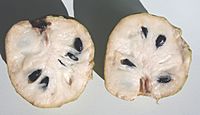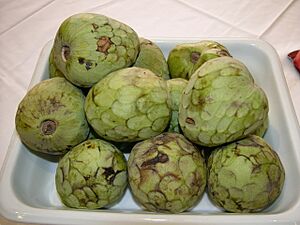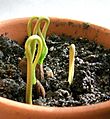Cherimoya facts for kids
Quick facts for kids Cherimoya |
|
|---|---|
 |
|
| Cherimoya fruit | |
| Scientific classification | |
| Kingdom: | |
| Division: | |
| Class: | |
| Order: | |
| Family: | |
| Genus: | |
| Species: |
A. cherimola
|
| Binomial name | |
| Annona cherimola |
|
The Cherimoya is a sweet fruit that grows mainly in countries like Peru, Ecuador, Colombia, and Bolivia. Inside, the cherimoya is soft and white. Its skin is green when it's ripe, but turns brown if it gets too ripe.
Cherimoyas have large, black seeds. These seeds are poisonous and should never be eaten, just like the skin. A cool fact about the cherimoya is that it can grow in high, mountainous places.
In India, especially in the northern parts, this fruit is called sitafal. This name comes from Sita, a goddess. In Sri Lanka, people call it "Wali Anoda (වැලි අනෝදා)".
The famous writer Mark Twain once said the cherimoya was "the most delicious fruit known to men." Because of its creamy inside, it's also often called a "custard apple."
What is a Cherimoya Plant?
A cherimoya plant can be a shrub or a small tree. It can grow up to 9 meters (30 feet) tall. Sometimes it loses its leaves in certain seasons, and sometimes it stays green all year.
The plant's flowers grow in small groups. Each flower is about 2–3 centimeters across and has six petals. They are usually yellow-brown and sometimes have purple spots near the bottom.
The Cherimoya Fruit
The cherimoya fruit is shaped like an oval, sometimes a bit flat. It is usually 10–20 centimeters long and 7–10 centimeters wide. The skin can be smooth or have small bumps.
The fruit's inside is white and creamy, with many dark brown seeds. When a cherimoya is ready to eat, its skin is green and feels slightly soft if you press it. People often say the fruit tastes like a mix of banana, pineapple, papaya, peach, and strawberry.
You can chill the fruit and eat it with a spoon. This is why some people call it the "ice cream fruit"!
Images for kids
-
Region of wild cherimoyas in Vilcabamba, Ecuador
-
A wild cherimoya plant in Vilcabamba, Ecuador
-
Nitidulidae's beetle on cherimoya flower, Jundiaí, Brazil
-
Plantation in south Andalucia
-
Cherimoya-shaped bottle made by the Cupisnique culture around 1000 to 700 BC on the coast of what is now Peru
See also
 In Spanish: Chirimoya para niños
In Spanish: Chirimoya para niños













